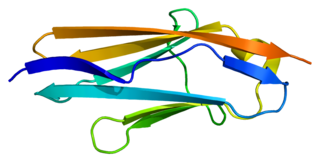
Bifunctional purine biosynthesis protein PURH is a protein that in humans is encoded by the ATIC gene.

Low affinity immunoglobulin gamma Fc region receptor II-a is a protein that in humans is encoded by the FCGR2A gene.

Calpastatin is a protein that in humans is encoded by the CAST gene.

Spliceosome RNA helicase BAT1 is an enzyme that in humans is encoded by the BAT1 gene.

Matrix metalloproteinase-19 (MMP-19) also known as matrix metalloproteinase RASI is an enzyme that in humans is encoded by the MMP19 gene.

Exosome component 10, also known as EXOSC10, is a human gene, the protein product of which is part of the exosome complex and is an autoantigen is patients with certain auto immune diseases, most notably scleromyositis.

Exosome component 7, also known as EXOSC7, is a human gene, the protein product of which is part of the exosome complex.

Exosome component 3, also known as EXOSC3, is a human gene, which is part of the exosome complex.

Exosome component 9, also known as EXOSC9, is a human gene, the protein product of which is part of the exosome complex and is an autoantigen is patients with certain auto immune diseases, most notably scleromyositis.

Sperm surface protein Sp17 is a protein that in humans is encoded by the SPA17 gene.

Exosome component 4, also known as EXOSC4, is a human gene, which is part of the exosome complex.

Interleukin 21 receptor is a type I cytokine receptor. IL21R is its human gene.

Enhancer of polycomb homolog 1 is a protein that in humans is encoded by the EPC1 gene.

Mediator of RNA polymerase II transcription subunit 7 is an enzyme that in humans is encoded by the MED7 gene.

Striated muscle preferentially expressed protein kinase, in the human is encoded by the SPEG gene, a member of the myosin light chain kinase protein family. SPEG is involved in the development of the muscle cell cytoskeleton, and the expression of this gene has important roles in the development of skeletal muscles, and their maintenance and function. Mutations are associated with centronuclear myopathies a group of congenital disorders where the cell nuclei are abnormally centrally placed.

Transcription factor RFX4 is a protein that in humans is encoded by the RFX4 gene.

Homeobox protein SIX2 is a protein that in humans is encoded by the SIX2 gene.

Ventral anterior homeobox 1 is a protein that in humans is encoded by the VAX1 gene.

Centrosomal protein of 76 kDa, also known as CEP76, is a protein that in humans is encoded by the CEP76 gene.

Early growth response protein 4 (EGR-4), also known as AT133, is a protein that in humans is encoded by the EGR4 gene.



















